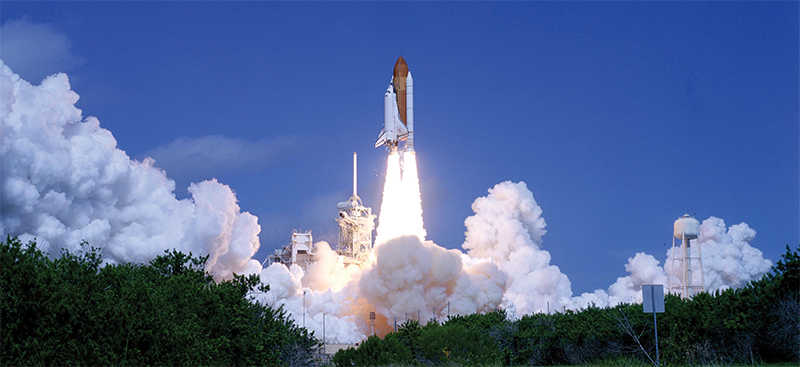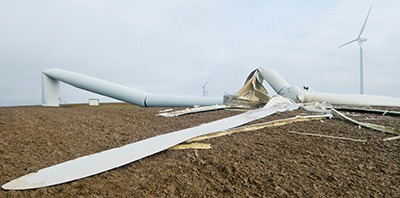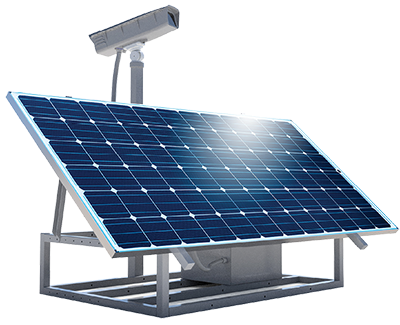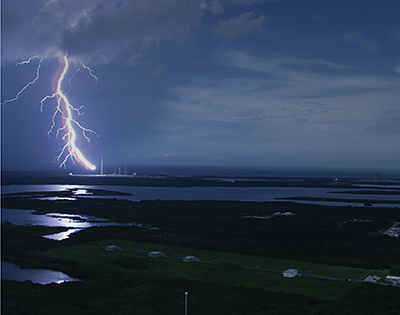
Surveillance System Captures, Maps Lightning Strikes
NASA Technology
On July 7, 2011, as Space Shuttle Atlantis sat on the launch pad just one day before it was due to make the final voyage of NASA’s 30-year Shuttle program, lightning struck. Twice.
The crucial questions for engineers and officials hoping to keep the launch on schedule were: where exactly did those strikes hit, and were they close enough to do any damage to the Shuttle’s electrical systems?
There were two systems monitoring lightning activity around Kennedy Space Center in 2011: the local Cloud-to-Ground Lightning Surveillance System (CGLSS) operated by the Air Force, which has a base nearby, and the National Lightning Detection Network (NLDN), a nationwide detection system owned and operated by a private company.
According to CGLSS, both lightning events struck pad A at Launch Complex 39, where Atlantis was waiting for launch. Neither system had a great track record at Kennedy—NASA investigations had determined they reported only 70 to 80 percent of lightning strikes and were prone to reporting strikes in locations where they did not actually occur.
Nevertheless, a launch, especially one with crew on board, cannot go forward when there is any question the spacecraft may have been damaged. “Problems on the ground are fixable, but if you launch something that has been compromised, you can get into a lot of trouble,” emphasizes Carlos Mata, who was the lightning subject matter expert at Kennedy for more than a decade before moving into the private sector.
In previous cases, a storm like this, with strikes so close, would have certainly demanded a delay while engineers retested potentially affected systems.
“And the retest could take a long time depending on which systems are involved. Several days to a week,” explains Kevin Decker, an engineer at Kennedy.
That is exactly why NASA had already begun working on a new lightning monitoring system focused directly on the launch pads, Mata says, “to make sure that if lightning struck within a certain radius, we will detect it. Period.
“We also wanted to be able to accurately locate it, but that was a secondary requirement.”
The new system incorporated a suite of high-speed cameras designed to capture visual evidence of any lightning striking the pad directly or nearby. The cameras are mounted on three lightning protection towers, as well as on the vehicle assembly building seven miles away, explains Decker, who serves as NASA’s lead design engineer on the system. The cameras’ overlapping fields of view ensure that, wherever there is a strike, images will be recorded by multiple cameras.
The towers also serve to support a lightning protection system for the launch vehicle. Wires are strung between the towers and down to the ground, providing a preferential place for lightning to strike and a path for the current to travel away from the vehicle on the pad.
Around a wider perimeter, there are electromagnetic field sensors installed at ground level, Decker adds. The electromagnetic sensors record the electric and magnetic fields generated by the lightning to measure both the intensity and strike location. “If you had a strike near the road leading up to the pad, for example, each of the electric field sensors would experience the field at slightly different times. And because we know how fast electric fields travel, we can actually triangulate within several meters of where that strike hit.”
In 2011, this system was not yet fully installed, but the cameras on the lightning protection towers were already operational and mounted at pad B, less than two miles from pad A, where Atlantis sat ready for launch. So when the storm hit, “the electromagnetics folks came to me and said, ‘Carlos, did you see anything?’” Mata recalls.
Indeed, the cameras had captured both strikes. Still pictures and video were able to show the bolts hitting nearby but not directly on the pad. As a result, STS-135 was not scrubbed that afternoon and took off the next day.
Technology Transfer
Mata spent several years fine-tuning the system at Kennedy. At NASA’s request, he built it almost entirely from off-the-shelf commercial components, but many needed to be modified and improved to meet his needs. For instance, he says, they modified the timing of the data acquisition system that records the outputs from the various sensors to better map lightning strikes that hit the ground in multiple places.
As the system improved, the lightning protection industry began to take note, and Mata was invited to speak about it at conferences and to industry groups around the country. In 2014, Mata visited a company in Connecticut, East Coast Lightning Equipment, and while there, he got to talking with the company owners.
“I told them I thought there was a commercial market for this,” Mata recalls. “And I think the light bulb went on. We started having conversations, and about two years later, Scientific Lighting Solutions LLC (SLS) was registered.”
Benefits
Recently, SLS has designed a next-generation lightning monitoring system called Optical Jupiter Precision Lightning Surveillance. Unlike the CGLSS and NLDN systems, which cover large geographical areas, the Optical Jupiter system is much more localized—but for the area under coverage, it detects 100 percent of strikes, Mata says. That’s a significant improvement over other commercial lightning detection systems, he adds, which have particular trouble locating strikes that touch down in multiple places—about half of all lightning strikes.
“There have been instances in which we’ve been told there’s been a strike to one launch pad, and our Optical Jupiter system proves it wasn’t there,” Mata says. “In other instances, Optical Jupiter detects a strike right on top of the launch pad, but it was not reported by the existing commercial systems.”
Mata says he suspects that subsequent lightning ground attachment points, which can hit some meters or even kilometers away from the first strike, confuse the algorithms in some lightning detection systems, which could cause the system to throw out the data altogether or misreport the strike locations.
That’s one of the reasons the imagery from the high-speed video cameras gives a big advantage: because they offer “location information not based on waveforms, but on actual visual observations. No need to do math,” Mata says.
Those pictures are a large part of why NASA officials felt confident enough in the relatively untested system in 2011 to keep the Atlantis launch a go, Decker says. “It’s tough to argue with video. You could see the strikes.”
But the instruments also provide other important data, including intensity measurements, which can help gauge potential damage. A stronger strike will be more damaging at its epicenter and could also be damaging over a wider area.
Kennedy continues to use its version of the system, and now the launch pad contractor has a subcontract with SLS, based in nearby Titusville, Florida, to continue maintaining and monitoring it on NASA’s behalf.
The technology is also useful outside of the aerospace industry. For example, lightning is a problem on wind farms, where the tall turbines are prone to damage from strikes. Amid acres of turbines, it can be hard to pinpoint which one was hit, Mata says, especially if it continues operating.
“The turbine blade could start falling apart, and once you lose one of the three, you lose the balance and then the whole tower collapses,” Mata says. However, if you are able to tell a particular wind turbine has been struck, “you can shut it down before it catastrophically fails. You’ll have time to fix it and bring it back to operational mode before you lose a wind turbine.”
Insurance companies can also use the Optical Jupiter system to reduce their need for in-person claims investigations, Mata says. Rather than sending a person each time a client reports a lightning strike, the company can use data from Optical Jupiter to verify whether and where a strike occurred.
Each standalone system works on solar power, communicates through telephone lines, and can cover an area around three kilometers in diameter, though Mata says the best coverage is within about a kilometer or so.
SLS can also build custom lightning detection and monitoring systems that include both high-speed cameras and electromagnetic field sensors. Its current customers include lightning protection businesses looking to provide lightning location services across wider areas, such as airports, military installations, and cities.
The designs of the Optical Jupiter and other SLS lightning detection and monitoring systems were strongly influenced by the work Mata and his team did at Kennedy.
“The learning that we went through at Kennedy helped tremendously in the development of SLS’s more advanced, next-generation products,” Mata emphasizes.

One application for the Optical Jupiter lightning detection system is on wind farms. Amid acres of turbines, it can be hard to pinpoint where damage occurred, but if you are able to identify which one was struck, you can shut it down before it catastrophically fails.

After debuting his lightning detection system at NASA, Carlos Mata left and founded Scientific Lightning Solutions to develop a commercial model, which includes high-speed video cameras powered by solar panels (top). The company also still maintains the system at Cape Canaveral, and in December 2016, it helped ensure the Cyclone Global Navigation Satellite Systemlaunch could proceed on schedule despite a fierce lightning storm days earlier.

The lightning detection system includes high- speed cameras that monitor the launch pad from near and far, ensuring that any lightning activity will be captured for analysis. This lightning strike was in July 2014.

In 2011, Space Shuttle Atlantis launched for the final voyage of the Shuttle program—but the launch was almost delayed because of a lightning storm the day before. An advanced lightning detection system, then still under development, helped show that the bolts had not been close enough to damage the spacecraft.













